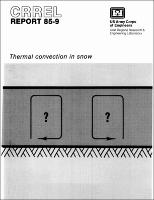Please use this identifier to cite or link to this item:
https://hdl.handle.net/11681/9395Full metadata record
| DC Field | Value | Language |
|---|---|---|
| dc.contributor | Thayer School of Engineering | - |
| dc.contributor.author | Powers, D. J. (Daniel J.) | - |
| dc.contributor.author | Colbeck, Samuel C. | - |
| dc.contributor.author | O'Neill, Kevin, 1946- | - |
| dc.date.accessioned | 2016-06-20T13:41:39Z | - |
| dc.date.available | 2016-06-20T13:41:39Z | - |
| dc.date.issued | 1985-05 | - |
| dc.identifier.uri | http://hdl.handle.net/11681/9395 | - |
| dc.description | CRREL Report | - |
| dc.description | Abstract: Large temperature gradients applied to a snow cover drive water vapor upwards and result in rapid recrystallization of snow crystals. The same temperature gradients create gradients of air density that can cause flows of air through the snow cover. The formalism necessary to describe these flows is developed here in an effort to include the convection of vapor in the understanding of snow metamorphism. The theory of convection through porous media is extended here to include the transport of water vapor, which is important because of its latent heat. Results are presented in terms of a Lewis number, defined as the ratio of thermal to mass diffusivities. For Lewis numbers greater than 1.0, phase change intensifies convection, and for Lewis numbers less than 1.0, phase change retards convection. Two boundary conditions of special interest in the study of snow, a constant heat flux bottom and a permeable top, are investigated. Their influence on the transfer of heat is quantified, and it is found that heat transfer can be described as a linear function of the driving force for convection. Convection in sloped layers is quantified, and explained in a physically consistent manner. The effect of a permeable top on convection at low Rayleigh numbers is derived. Experiments are performed to measure the effects of convection on heat transfer through glass beads and snow. The model results using constant flux boundary conditions are confirmed by the experiments. Experiments show that convection can occur in snow, and that convection behaves in a manner consistent with our theoretical understanding of the phenomenon. Some uncertainty exists about the permeability and thermal conductivity of snow and hence it is uncertain if thermal convection would occur for a given temperature gradient, density and thickness. Also, for a given convective intensity, there is much uncertainty about how much the rate of snow metamorphism is increased. | - |
| dc.publisher | Cold Regions Research and Engineering Laboratory (U.S.) | - |
| dc.publisher | Engineer Research and Development Center (U.S.) | - |
| dc.relation | http://acwc.sdp.sirsi.net/client/en_US/search/asset/1006784 | - |
| dc.relation.ispartofseries | CRREL report ; 85-9. | - |
| dc.rights | Approved for public release; distribution is unlimited. | - |
| dc.source | This Digital Resource was created from scans of the Print Resource | - |
| dc.subject | Experimental data | - |
| dc.subject | Heat flux | - |
| dc.subject | Mathematical models | - |
| dc.subject | Snow | - |
| dc.subject | Snow flakes | - |
| dc.subject | Snow crystals | - |
| dc.subject | Thermal properties | - |
| dc.subject | Vapor flux | - |
| dc.title | Thermal convection in snow | - |
| dc.type | Report | en_US |
| Appears in Collections: | CRREL Report | |
Files in This Item:
| File | Description | Size | Format | |
|---|---|---|---|---|
| CR-85-9.pdf | 3.49 MB | Adobe PDF |  View/Open |